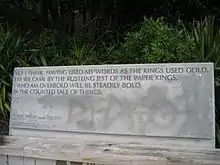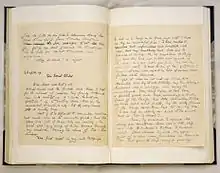Robin Hyde | |
|---|---|
_(cropped).jpg.webp) | |
| Born | Iris Guiver Wilkinson 19 January 1906 Cape Town, Cape Colony |
| Died | 23 August 1939 (aged 33) Kensington, London, England |
| Resting place | Kensington New Cemetery |
| Occupation | Author |
| Language | English |
| Citizenship | British subject |
| Education | Wellington Girls' College, Victoria University of Wellington |

Robin Hyde, the pseudonym used by Iris Guiver Wilkinson (19 January 1906 – 23 August 1939), was a South African-born New Zealand poet, journalist and novelist.
Early life
Wilkinson was born in Cape Town to an English father and an Australian mother, and was taken to Wellington before her first birthday. She had her secondary education at Wellington Girls' College, where she wrote poetry and short stories for the school magazine. After school she briefly attended Victoria University of Wellington. When she was 18, Hyde suffered a knee injury which required a hospital operation. Lameness and pain haunted her for the rest of her life. In 1925 she became a journalist for Wellington's Dominion newspaper, mostly writing for the women's pages. She continued to support herself through journalism throughout her life.[1]
Later life
While working at the Dominion, she had a brief love affair with Harry Sweetman, who left her to travel to England. In 1926, in Rotorua for a holiday and treatment for her tubercular knee, Hyde had an affair with Frederick de Mulford Hyde. When Hyde fell pregnant, Frederick paid for her to have the child in Sydney, Australia. Their son, Christopher Robin Hyde, was stillborn. She was to adopt the name 'Robin Hyde' as a 'nom de guerre', to preserve his memory. On her return to New Zealand in December 1926, she discovered that Frederick had married. Traumatised by the loss of her child, Hyde was hospitalised at Queen Mary Hospital in Hanmer Springs and then cared for at the family home in Wellington, though only her mother knew of the pregnancy.[2]
After a period of recovery, she began to write again, publishing poetry in several New Zealand newspapers in 1927. She was also engaged to write columns for the Christchurch Sun, and the Mirror. However, she became frustrated at the lack of creative input, as the papers merely wanted a social column. Social columns or women's pages were the main outlet available to women journalists during the period. These experiences contributed to her treatise on journalism in New Zealand, Journalese, published in 1934.[3]
In 1930, while working for the Wanganui Chronicle, Hyde had an affair with the Marton-based journalist Harry Lawson Smith. Their son, Derek Arden Challis, was born in Picton that October. Lawson Smith was married, and his only relationship with Hyde and their son was to provide sporadic maintenance payments. In time Hyde's mother learned of Derek's existence, but her father was never told.[4]
In 1929 Hyde published her first book of poetry, The Desolate Star. Between 1935 and 1938 she published five novels: Passport to Hell (1936), Check To Your King (1936), Wednesday's Children (1937), Nor the Years Condemn (1938), and The Godwits Fly (1938). A manuscript of her unpublished autobiography was given to Auckland Libraries by Dr Gilbert Tothill.[5]

Final years and death
In early 1938 she left New Zealand and travelled to Hong Kong, arriving in early February. At the time, much of eastern China was under Japanese occupation, after the 1931 Japanese invasion of Manchuria. Hyde was meant to travel to Kobe then Vladivostok to take the trans-Siberian railway to Europe. When the connection was delayed she made her way to Japanese-occupied Shanghai, where she met fellow New Zealander Rewi Alley. Various peregrinations through China followed, including Canton and Hankou, the latter of which was the centre of Chinese resistance to Japanese occupation. She moved north to visit the battlefront and was in Xuzhou when Japanese forces took the city on 19 May.
Hyde attempted to flee the area by walking along the railway lines and was eventually escorted by Japanese officials to the port city of Qingdao where she was handed over to British authorities. Shortly after she resumed her journey to England via sea, arriving in Southampton on 18 September 1938. She died by her own hand with an overdose of Benzedrine[6] at 1 Pembridge Square, Kensington, a boarding house where she had been living.[7] She was survived by a son, Derek Challis, and was buried in the Kensington New Cemetery, at Gunnersbury.
References
- ↑ Matthews, Jacqueline. "Hyde, Robin". Dictionary of New Zealand Biography. Ministry for Culture and Heritage, New Zealand Government. Retrieved 30 March 2011.
- ↑ Challis, Derek and Rawlinson, Gloria (2002), The Book of Iris: A Life of Robin Hyde, Auckland University Press
- ↑ Hyde, Robin (1934). Journalese. Auckland: The National Printing Company.
- ↑ Challis, Derek and Rawlinson, Gloria (2002), The Book of Iris: A Life of Robin Hyde, Auckland University Press, p. 207
- ↑ Sharp, Iain (2007). Real gold : treasures of Auckland City Libraries. Auckland University Press.
- ↑ New Zealand History - Writer Robin Hyde Dies in London
- ↑ Journal of New Zealand Literature, Issues 15-17 (1997), p. 25
External links
- ""Robin Hyde" article by Mary Edmond Paul in "Kotare", 2007". NZETC. 2007.
- Profile from The Oxford Companion to New Zealand Literature at Read NZ Te Pou Muramura
- New Zealand Electronic Poetry Centre: Online works and articles
- Iris Wilkinson (Robin Hyde) Online works in NZ Electronic Text Centre
- Poems in Kowhai Gold (1930)
- Te Ara: 1966 article from An Encyclopaedia of New Zealand
- Robin Hyde in China at the NZEPC, Auckland University
- Real Gold, Treasures of Auckland City Libraries - Robin Hyde
- Robin Hyde's Collected Parliamentary Reports, edited by Nikki Hessell
